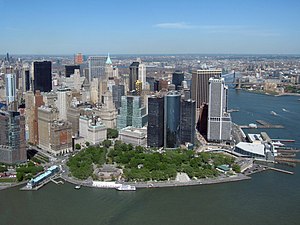
Back Battery Park Catalan Battery Park (parke sa Tinipong Bansa, New York) CEB Battery Park Danish The Battery German The Battery (Manhattan) Spanish Battery Park Estonian Battery Park Basque پارک بتری Persian Battery Park Finnish The Battery (Manhattan) French
| The Battery | |
|---|---|
| Battery Park | |
 Aerial view of the Battery in 2010. At park's left is Pier A, at park's right is South Ferry Terminal. On the far right is the East River. | |
 | |
| Location | Southern tip of Manhattan Island in New York City; bounded by New York Harbor to the south |
| Coordinates | 40°42′13″N 74°00′58″W / 40.70361°N 74.01611°W |
| Area | 25 acres (10 ha) |
| Created | 1823 |
| Etymology | Artillery battery |
| Owned by | New York City Department of Parks and Recreation |
| Operated by | The Battery Conservancy |
| Open | 6 a.m. to 1 a.m. |
| Public transit access | Bus: M15 SBS, M20 and M55 Subway: |
| Website | NYC Parks The Battery Conservancy |
The Battery, formerly known as Battery Park, is a 25-acre (10 ha) public park located at the southern tip of Manhattan Island in New York City facing New York Harbor. It is bounded by Battery Place on the north, with Bowling Green to the northeast, State Street on the east, New York Harbor to the south, and the Hudson River to the west. The park contains attractions such as an early 19th-century fort named Castle Clinton; multiple monuments; and the SeaGlass Carousel. The surrounding area, known as South Ferry, contains multiple ferry terminals, including the Staten Island Ferry's Whitehall Terminal; a boat launch to the Statue of Liberty National Monument (which includes Ellis Island and Liberty Island); and a boat launch to Governors Island.
The park and surrounding area is named for the artillery batteries that were built in the late 17th century to protect the fort and settlement behind them. By the 1820s, the Battery had become an entertainment destination and promenade, with the conversion of Castle Clinton into a theater venue. During the mid-19th century, the modern-day Battery Park was laid out and Castle Clinton was converted into an immigration and customs center. The Battery was commonly known as the landing point for immigrants to New York City until 1892, when the immigration center was relocated to Ellis Island in the middle of the harbor. Castle Clinton (sometimes called, Castle Garden) then hosted the New York Aquarium from 1896 to 1941.
By the 20th century, the quality of Battery Park had started to decline, and several new structures were proposed within the park, many of which were not built. In 1940, the entirety of Battery Park was closed for twelve years due to the construction of the Brooklyn–Battery Tunnel and the Battery Park Underpass. The park reopened in 1952 after a renovation, but then subsequently went into decline. The Battery Conservancy, founded in 1994 by Warrie Price, underwrote and funded the restoration and improvement of the once-dilapidated park. In 2015, the Conservancy restored the park's historical name, "the Battery".